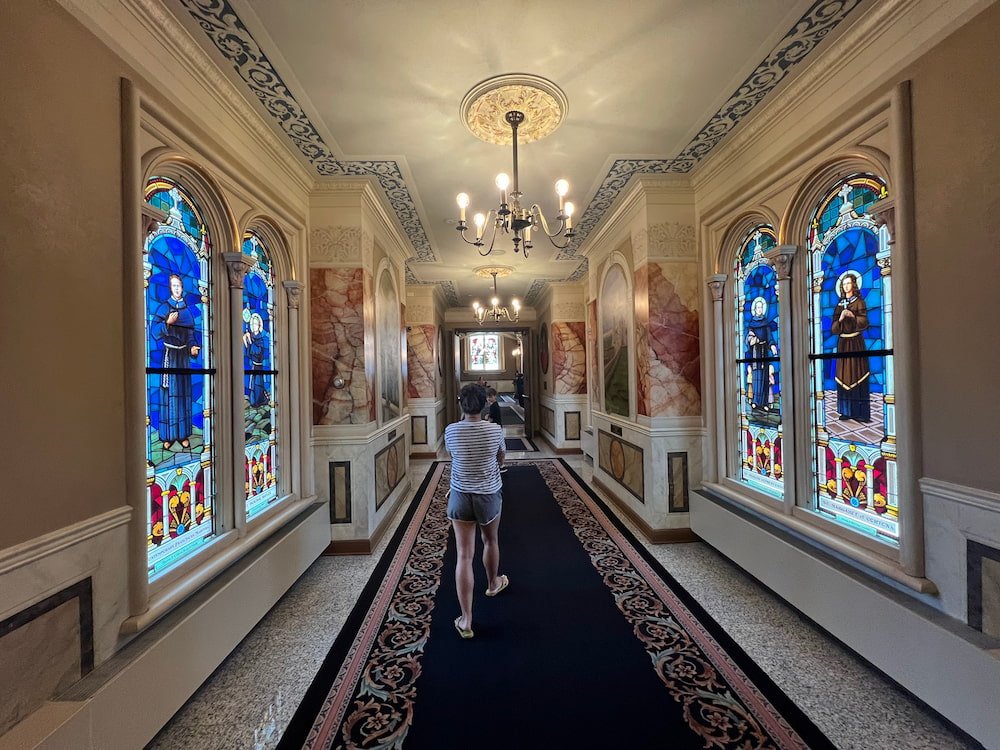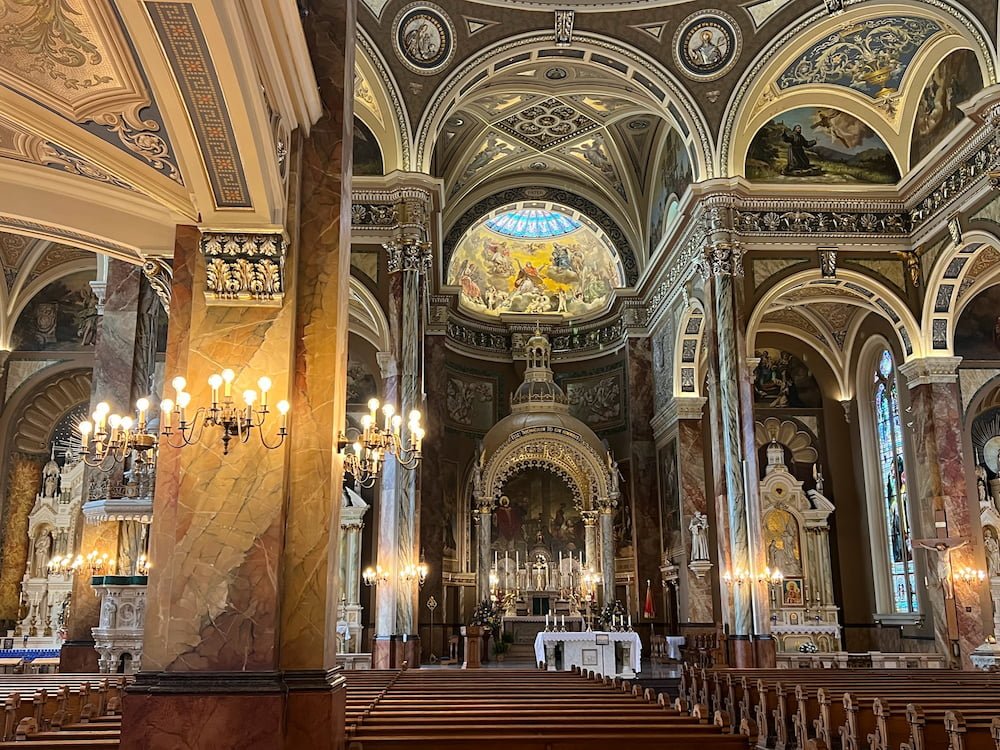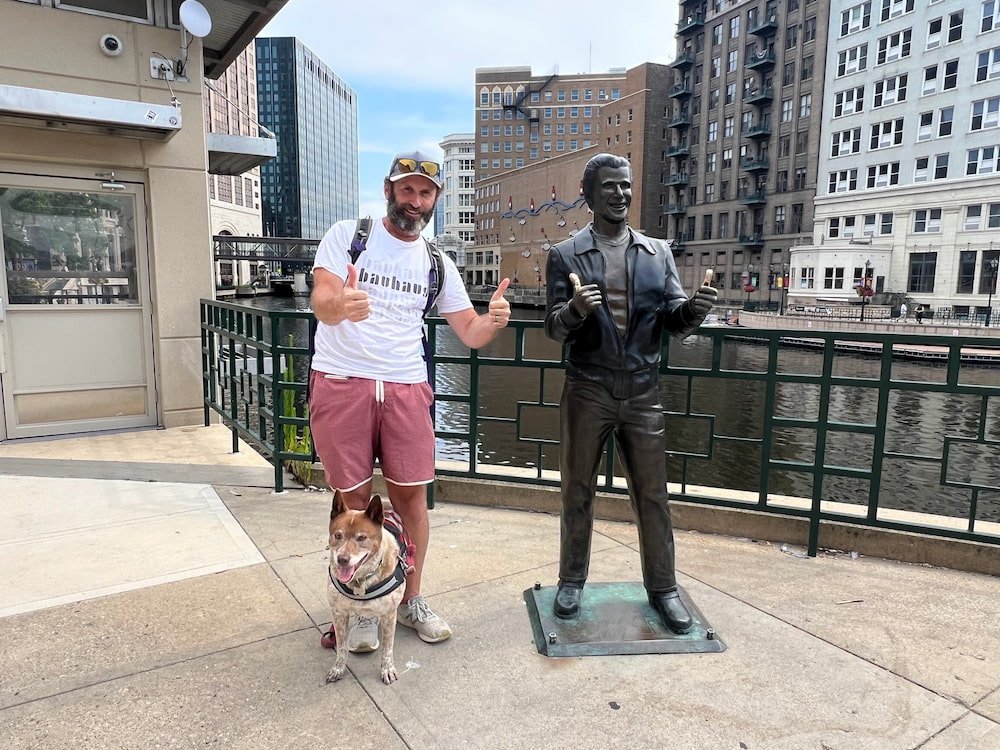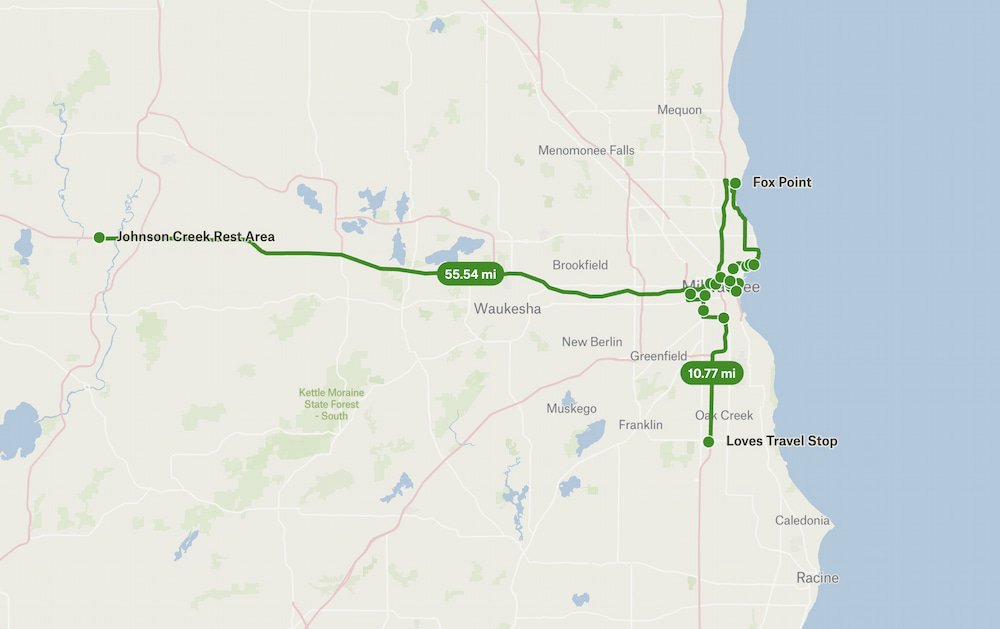After planning our itinerary the day prior, we realized that we could probably check out everything we wanted to see in Milwaukee in a day (which we did)! We first visited the Basilica of St. Josephat, which was built by the Polish community, as thousands had migrated to Milwaukee in the 1800s. The basilica's construction was finished in 1901, in what is now a predominantly Latin neighborhood. In the Catholic Church, a church is called a basilica for the largest, most beautiful and historically significant churches, and in 1929, St. Josephat Church attained basilica status, the third one in the U.S. to do so. It's the largest church in Milwaukee, and can seat over 1,000 people on the main floor, with hundreds more in the gallery upstairs.

We entered just as the basilica opened at 10am, and there was already a tour happening inside. It's very ornate inside, with beautiful stained glass windows, gold leaf detailing, murals depicting biblical scenes high up into the dome, and Polish words painted high up into the ceiling. It's a grand and very intricately designed basilica. Downstairs, there's a gift shop, as well as a few exhibits that go into further detail about the basilica's history.





Frank Lloyd Wright Homes
We'd visited Frank Lloyd Wright's Dana-Thomas House in Springfield, Illinois only a few days ago, and not too far from the basilica we stopped outside the Burnham Block, which Lloyd designed from 1912-1916 as a model for affordable housing. The neighborhood also seems to still be in an area that isn't particularly affluent, and we had to battle bumpy, potholed streets to get here (as it turns out, the roads all throughout Milkwaukee are rather terrible). Unfortunately we couldn't go inside the homes as they are only available to tour on Saturdays, by reservation only.


The 3 Domes
The Mitchell Park Horticultural Conservatory is also known as the Domes, because there are 3 large and distinct domes that serve as greenhouses to the over 1,800 plant species that live there, which are from all over the world. There's the Desert Dome (flora from the deserts of Africa, Madagascar, and the Americas), the Floral Dome (seasonal flowers), and the Tropical Dome (over 1,200 plant species from rainforest environments).

We didn't go inside, but spent some time wandering around the pretty grounds around it. There's also a very unique sundial, called the Human Gnomon Analemmatic Sundial, which uses a person to figure out what time it is! You stand at the date location in the center, and lift your arms up overhead to see what hour it corresponds to. There were two different sets of date locations, for when it's daylight saving and when it's not. Michael tried it, and the sundial was correct in identifying what time it was!
Marquette University and the Oldest Chapel
After enduring the beat-up and cracked streets of Milwaukee, we arrived at Marquette University, a private Jesuit research university. The university campus is really pretty, and we were here to visit the gothic St. Joan of Arc Chapel, which dates to the early 15th century.

It's a tiny chapel, and we took turns to go in so that one of us would be outside to mind Sheila. When Lisette went in, there was a person who worked at the university who was inside, Robert, who was very helpful in providing more information on the chapel. It's apparently the oldest building in the Western Hemisphere still used for its original purpose. Mass services are held everyday during the school year, and interestingly, Robert said that the most popular time for students is at 10pm.

The chapel initially came from France to New York in the 1920s, before arriving at Marquette University in the 1960s. It was renamed as St. Joan Chapel in the US, but before doing that it needed to have obvious connections to the French saint. To do this, stained glass was taken from French churches where St. Joan was said to have gone into, and repurposed to the stained glass that appears in the chapel today. Additionally, there's a "Joan of Arc Stone" that is believed to be the one where St. Joan prayed upon before battle. It's at the front of the chapel, next to the altar, where there's also a statue of St. Joan.

One of the other really fascinating aspects of the chapel is a statue of Jesus, with saints Peter and Paul on either side of him. These statues hang above the entrance door of the chapel. Jesus has no arms, but when you look carefully, the light bouncing off the two saints makes it so that their shadow gives Jesus wings!
A Pabst from the Past
As our friend Jessica mentioned to us when we saw her in Chicago, Wisconsin is big on beer, and we checked out the Best Place at the Historic Pabst Brewery, which conducts tours, and has a cafe and gift shop in the vicinity. Pabst Brewing Company was founded in 1844 in Milwaukee by Jacob Best and later named after Frederick Pabst, two German immigrants, and in the late 1800s the company was the nation's largest brewer, and the first to sell more than one million U.S. barrels of beer in a year.



The Pabst's headquarters are now in San Antonio, and Pabst is no longer brewed in Milwaukee, but the huge brewery buildings still exist, and there's a cool exhibit built into the ground that tells the company's history, includes Braille captions on the plexiglass, and also has various artifacts as well behind the plexiglass.
It's Quiet Downtown
Lisette commented that it seems that based on the roads, the buildings, and some of the cars (which are missing headlights, bumpers, and are very rusty), it seems that Milwaukee in parts is really rundown. Like it was in its prime years ago, but is hanging on to what's still around. A fascinating city with a lot of history, but could do with renovations.

When we arrived in the downtown area, we saw a few impressive buildings. The Milwaukee County Courthouse, for example, is the biggest courthouse we have ever seen! It stood out as we drove towards it on the highway, looking very stately with its neoclassical design and numerous pillars. We also went into the Milwaukee Public Library, which has a beautiful dome design inside. It also offers tours of the building.

Oddly, despite these big buildings downtown, Milwaukee on a weekday seemed really quiet. Perhaps people working were in their offices, but there weren't as many people walking around the city streets. Some U.S. cities, like San Francisco, still haven't fully reached the same level of busy as before the COVID pandemic, although it's starting to change more as companies expect their employees to return to the office. Perhaps Milwaukee is experiencing the same?



Public Market and Riverwalk Area
Not far from the Milwaukee River is the Milwaukee Public Market, where it was definitely busier with people shopping and eating inside this marketplace that offers oysters, baked goods, meats, prepared meals, and other gourmet foods. We enjoyed strolling through even to look at the various produce--including of course, specialty cheeses!




Walking distance from the Public Market is a building with three 6-feet ladybugs clinging to the side of it. The "Ladybug Building" is a fun art installation, which was a good segue to the the pretty Milwaukee Riverwalk, that has various art pieces along the way. There's a sculpture of the Fonz, a popular character from the TV sitcom "Happy Days", which aired from the 1970s to 1980s, but was set in 1950s and 1960s Milwaukee. Further along, we also saw a mural on the other side of the water for the city of Milwaukee. There was a bridge that lifted straight up while we were near this mural to make way for what we thought would be a big vessel, only to see a small boat sail through, that definitely would have fit under the bridge!




A Bit of Spain in Milwaukee
We only briefly stopped at the The Milwaukee Art Museum, which is one of the largest art museums in the U.S., with over 34,000 art works spanning 150,000 square feet (almost 14,000 square meters). Upon arriving there, one of the buildings, the Quadracci Pavilion, struck us as being very similar to the City of Arts and Sciences that we'd seen when we visited Valencia in Spain years ago. The two buildings have the same architect: Santiago Calatrava, from Spain, and both structures are gigantic, slanted white buildings, with the one in Milwaukee shaped somewhat like wings in flight. Driving away from the Art Museum, we drove down a street and could see it in the distance, where this visual could be seen and appreciated even more.

Local Art: The 3 Stooges and the Black Cat Alley
Another option for beer tours besides Pabst is the Lakefront Brewery, which was started by 2 brothers in Milwaukee in 1987. Today, more than 80,000 people tour the brewery each year, which sits on the riverfront and produces 20 varieties of IPA and specialty beer. Since we're not big beer drinkers we didn't go on the tour, but we did really like the sculptures of the Three Stooges, the classical American comedy troupe, at the front of the brewery. There are 3 metal outdoor sculptures that have their faces painted on each, reusing large vats that were once inside the brewery.


For more art, there's also the Black Cat Alley, which has about 20 outdoor murals from various artists. At the time we went, there were murals that were anime-inspired as a tribute to a Milwaukee baseball legend ("Wild Bill"), and others that were making a statement about political and current affairs ("The Subtraction of Children" about the war in Gaza). There were also poems on the cement ground as we walked through. Separate to Black Cat Alley, but on the street parallel to it is another huge mural called "Glitch Frog", simply of a cool French frog in Milwaukee!

Our last stop in Milwaukee was the Old North Point Water Tower, which at one point provided the city with 16 million gallons of water a day. It's a Victorian Gothic-style tower that kind of reminded us of a tower from a fairy tale--it wouldn't be too out of place if Rapunzel was at the top letting down her long hair! It's in the middle of the road, but we could easily park across from it to simply look at this piece of history.

As we left Milwaukee, we drove past American Family Field, the ballpark of its baseball team, the Milwaukee Brewers. We'd driven past it earlier, but we couldn't get too close as it was gated off and there were no games on. After driving through some terrible roads in the city, as we drove north we noticed that the neighborhood also became much fancier--clearly areas like the residential suburbs Fox Point, alongside the water, were very nice places to live!

Our route took us west, and we drove for over 50 miles or so before parking in a rest stop off the highway, next to trucks who were also briefing stopping or parking for the night. Tomorrow we'll be exploring Madison, another city in Wisconsin!
Route Map


[…] and opulence of churches like the Cathedral Basilica of St. Louis in Missouri, and the Basilica of St. Josephat in […]